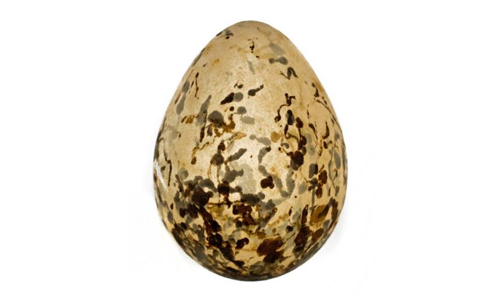Rare eggs over 100 years old to forget in the drawer
A museum manager happened to see an egg in a drawer, discovered it was collected over 100 years ago and left in the archive .
Found rare eggs over 100 years old in the drawer
Alan Knox noticed the strange egg while looking for insect killings in the storage room of the animal museum at Aberdeen University , England. The egg is in a drawer containing many specimens that have not been included.

The egg is the only egg that humans have obtained from Rhinoptilus bitorquatus.(Photo: Aberdeen Museum)
Knox discovered the 2008 egg. Soon after, he quickly checked some basic information and was surprised at what he found. Test results show that the egg does not belong to any known bird species.
He could not find any official description of the rare bird's egg that Jerdon discovered. This made Knox come to the conclusion that the specimen in his hand was an egg of a rare species. Plover birds live in southern India.
They only know their existence through a few small specimens. In 1844, the British zoologist, Thomas Jerdon, collected a specimen for the first time. They were then given the scientific name Rhinoptilus bitorquatus.
During the 20th century, almost all believed that the bird Jerdon found was extinct. In 1986, a hunter suddenly discovered an individual Rhinoptilus bitorquatus still living near Kadapa town, Andhra Pradesh, India . He caught the bird and raised it for a while. Bharat Bhushan, a bird expert from Bombay Natural History Association, came to the site and tested the existence of precious birds.
However, there are still many questions around this specimen.'How can one identify something that no one has ever known before?' , Knox questioned in the University of Aberdeen magazine.
Maybe someone made a mistake in labeling the samples? Maybe the egg belongs to another bird, not Rhinoptilus bitorquatus? And if this is the case, how does this extremely rare egg come to Aberdeen?
In the end, Alan Knox found the answer from the DNA test results. Only five skin samples of the species Rhinoptilus bitorquatus are preserved. Two of them belong to a collection at London's Museum of Natural History. A Knox colleague Stuart Piertney took samples from eggs and skin samples from London and compared them.
"Test results show that the DNA of the two specimens completely coincides, which means they are the same species," Knox and Piertney published in the Bombay Natural History Association magazine.

One of the first images of rare birds that Thomas Jerdon discovered.(Photo: Guardian)
The road to the Aberdeen Museum of the egg is also very interesting. According to Knox, it was collected in 1917 by Ernest Gilbert Meaton, a veterinarian working in Bangalore, southern India.
Later George Falconer Rose, an engineer and businessman in Calcutta, bought a collection of Meaton. Some time later, Rose donated an egg to his old school, Aberdeen Pedagogical School. Finally in 1978, the egg was put into the Aberdeen Zoological Museum and was there until Knox discovered it.
"Who knows what treasures in this museum are waiting for us to discover, " Knox and Piertney concluded with humor.
Rhinoptilus bitorquatus is an extremely endangered bird species in the International Union for Conservation of Nature's Red List (IUCN) . The egg above is the only fruit of this species that humans have. After a period of display, it was put into the Aberdeen Zoological Museum's archives for better preservation.
- Very rare eye round eggs
- 9-year-old boy found fossil dinosaur eggs 66 million years
- Tiny, oddly shaped but this chicken egg can sell for 15 million VND
- Why do we sometimes forget what I was just about to say?
- Should eggs be eaten every day?
- 7 ways to eat nutritious eggs without getting bored
- How to eat eggs correctly?
- Discover an intact egg after thousands of years
- Magically rare parrot born from stamping eggs
- Warning: Stop working immediately for children under 5 to eat duck eggs
- Rare precious turtles lay eggs
- Indonesian boys have the most rare malformations: born with 2 faces and 2 brains
 Discovered an ancient centipede fossil 99 million years old
Discovered an ancient centipede fossil 99 million years old Discovered bat-like dinosaurs in China
Discovered bat-like dinosaurs in China Discovered a 200-year-old bronze cannon of the coast
Discovered a 200-year-old bronze cannon of the coast Discover 305 million-year-old spider fossils
Discover 305 million-year-old spider fossils Scientists puzzled by mysterious 'golden egg' found at the bottom of the deep sea, unclear what this object is
Scientists puzzled by mysterious 'golden egg' found at the bottom of the deep sea, unclear what this object is  Workers picked up a rock with a human face pattern, which could be an alien code.
Workers picked up a rock with a human face pattern, which could be an alien code.  You may not know: The elephant bird egg is the largest bird egg in history.
You may not know: The elephant bird egg is the largest bird egg in history.  World's oldest albatross lays egg at age 74
World's oldest albatross lays egg at age 74  The chicken or the egg came first - the question has the answer
The chicken or the egg came first - the question has the answer  Scientists discover 'selfish' chromosome causes miscarriages
Scientists discover 'selfish' chromosome causes miscarriages 